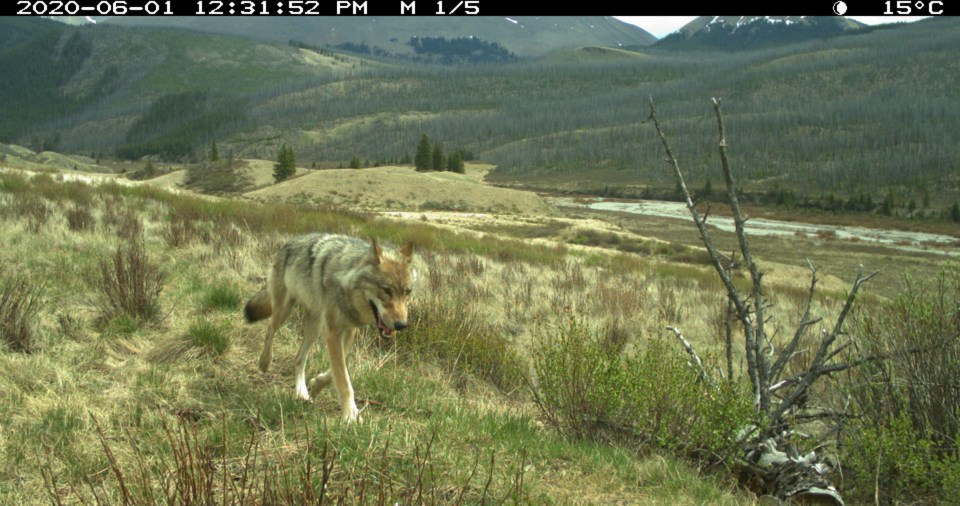BANFF – A wolf pup from the Bow Valley pack has been hit and killed by a train on the Canadian Pacific Railway line.
Shortly after midnight on Nov. 9, Parks Canada dispatch received a report of a wolf struck by a train near mile marker 89.7 along the train tracks west of the Hillsdale Split near the Bow Valley Parkway.
“Upon investigation, Parks Canada staff confirmed a grey, female young-of-year wolf had been struck and killed by the train,” said Justin Brisbane, a spokesperson for Banff National Park.
“The wolf was a member of the Bow Valley wolf pack. The investigation found no evidence of wildlife attractants nearby.”
The Bow Valley wolf pack continues to actively use the Bow Valley. It currently consists of an estimated six wolves, including the breeding pair.
Earlier this spring, Parks Canada confirmed there were at least six pups born, and possibly as many as nine. The fate of all of those pups is not known at this time.
In June, one of two yearling wolves fitted with a tracking collar was struck by a vehicle and killed on the Trans-Canada Highway near Castle Mountain.
The former alpha male of the pack, known as 1901, was killed on the highway just west of Banff in spring 2020, one more in a lengthy line of wolf deaths on the highway and train tracks since wolves recolonized the Bow Valley in the mid-1980s.
Reg Bunyan, vice-president of the Bow Valley Naturalists, said Parks Canada has put significant effort into many of the major cornerstones of ecological integrity, which have met with varying degrees of success.
“The one issue that continues to elude their efforts is railway wildlife mortality and in particular, the carnage with wolves and bears that we continue to see on the tracks,” said Bunyan, a retired resource conservation officer with Parks Canada who has dragged many wildlife carcasses from the tracks over his lengthy career.
“We seem to be in this tug of war with CP rail over the concept of shareholder value and the push for longer, faster trains while conveniently ignoring the collateral damage of the impact of those decisions.”
In a time of increasing focus on environmental governance concerns, Bunyan said BVN has yet to see CP make a formal commitment to reduce railway wildlife mortality or undertake any meaningful actions.
“As Ms. Greta Thunberg would say, until then, it’s just a lot of “blah blah” and our wolf and grizzly bear populations will continue to suffer,” he said.
Railways are a major source of direct mortality for many populations of large mammals around the world, but they have been far less studied and seen fewer mitigations than highways and roads.
In 2010, CP Rail and Parks Canada joined forces to investigate ways to reduce grizzly bear mortality on the railway line through Banff and Yoho national parks, with support from researchers from the University of Alberta and University of Calgary.
The $1 million study, which tracked a minimum of 11 and 13 grizzly bears fitted with GPS collars, wrapped up in 2016 and concluded wildlife mortality was a complex issue, with no one silver bullet solution.
However, the speed of trains was found to be one of the leading reasons behind wildlife deaths on the train tracks.
A follow-up study published last year in Nature’s Scientific Reports examined 646 railway mortality incidents for 11 wildlife species, including 59 bears, over a 24-year period spanning from 1995 to 2018.
The study supported suggestions by other researchers that reducing train speed could be an effective mitigation, particularly in known hotspots where the track curves combined with other impediments to animal movement.
Colleen Cassady St. Clair, who headed up the Parks Canada-CP five-year study, and Jesse Whittington, a Parks Canada wildlife ecologist in Banff National Park, were two of the authors of the study.
At the time of the paper’s release, Whittington said the two main factors affecting mortality rates for animals such as grizzly bears, wolves and elk was their ability to detect and escape from trains.
He said most animals were more likely to be killed in areas by water, near steep and rugged topography and in areas with lots of dense shrubs.
“In those cases, animals have few options for getting off the track, and in some ways they’re trapped,” he said.
“Trains can travel quickly, there’s high track curvature, there’s lots of water, steep slopes, and dense shrub cover.”
Brisbane said the federal agency continues to strive to reduce overall mortality on the railway line.
He said projects currently underway include improving wildlife travel routes away from the railway near mortality hotspots or in areas with thick shrubs or deadfall, as well as improving bear habitat away from the tracks through prescribed fire and forest thinning.
“Parks Canada has worked to establish alternative wildlife trails through dense vegetation, adjacent to 50 kilometres of railway tracks, in order to improve wildlife movement,” said Brisbane.
Following the death of the wolf pup, last week, Canadian Pacific Railway didn’t have much to say when asked what has been done coming out of its $1 million, five-year study to help prevent wildlife deaths.
“CP completed its multi-year vegetation management program throughout Banff and Yoho national parks and will continue to focus on science-based mitigations to prevent wildlife mortality on the railway,” said spokesperson Salem Woodrow in an email.




